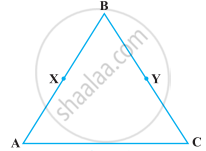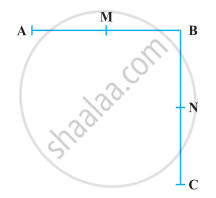Advertisements
Advertisements
प्रश्न
Why is Axiom 5, in the list of Euclid’s axioms, considered a ‘universal truth’? (Note that the question is not about the fifth postulate.)
उत्तर
Axiom 5 states that the whole is greater than the part. This axiom is known as a universal truth because it holds true in any field and not just in the field of mathematics. Let us take two cases − one in the field of mathematics and one other than that.
Case I
Let t represent a whole quantity, and only a, b, and c are parts of it.
t = a + b + c
Clearly, t will be greater than all its parts a, b, and c.
Therefore, it is rightly said that the whole is greater than the part.
Case II
Let us consider the continent Asia. Then, let us consider a country India which belongs to Asia. India is a part of Asia and it can also be observed that Asia is greater than India. That is why we can say that the whole is greater than the part. This is true for anything in any part of the world and is thus a universal truth.
APPEARS IN
संबंधित प्रश्न
Consider two ‘postulates’ given below:-
- Given any two distinct points A and B, there exists a third point C which is in between A and B.
- There exist at least three points that are not on the same line.
Do these postulates contain any undefined terms? Are these postulates consistent? Do they follow from Euclid’s postulates? Explain.
Given three distinct points in a plane, how many lines can be drawn by joining them?
How many planes can be made to pass through a line and a point not on the line?
The number of dimensions, a solid has ______.
It is known that if x + y = 10 then x + y + z = 10 + z. The Euclid’s axiom that illustrates this statement is ______.
Solve the following question using appropriate Euclid’s axiom:
It is known that x + y = 10 and that x = z. Show that z + y = 10?
Solve the following question using appropriate Euclid’s axiom:
Look at the figure. Show that length AH > sum of lengths of AB + BC + CD.

Solve the following question using appropriate Euclid’s axiom:
In the following figure, we have BX = `1/2` AB, BY = `1/2` BC and AB = BC. Show that BX = BY.

In the following figure AB = BC, M is the mid-point of AB and N is the mid-point of BC. Show that AM = NC.

Read the following axioms:
- Things which are equal to the same thing are equal to one another.
- If equals are added to equals, the wholes are equal.
- Things which are double of the same thing are equal to one another.
Check whether the given system of axioms is consistent or inconsistent.
